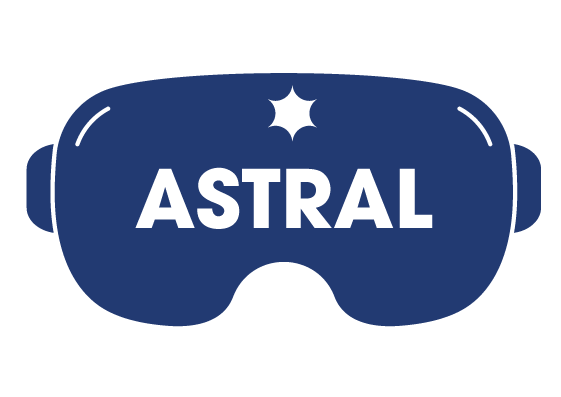Objectives
The ASTRAL project is part of exploratory research aimed at understanding the role and implications of Augmented Reality (AR) avatars in various contexts.

Technological
development
Design advanced techniques for displaying avatars in AR, overcoming the challenges of body segmentation, diminished reality and visual rendering.

User
interaction
Exploring methods for users to interact with avatars in AR, focusing on direct and mediated interactions with real and virtual objects.

Perception and psychosocial impact
Assessing the impact of AR avatars on self-perception, immersive presence and the potential Proteus effect, as well as the associated psychosocial and societal implications.
Work Packages (WP)
WP1: Avatarisation in AR
In this WP, we are focusing our efforts on developing advanced techniques for displaying avatars in AR. This includes semantic body segmentation, diminished reality and the capture of the physical environment. By integrating AR platforms such as VST (Video See-Through) and OST (Opticel See-Through) devices, we aim to create a solid foundation for the implementation of realistic avatars in AR environments.
WP1.1: Reduced reality solutions for AR avatars (Leader: IMT-Atlantique)
This task focuses on the prerequisites for avatar display in AR, including semantic body segmentation, diminished reality and tracking evaluation. By integrating existing techniques and incremental advances, we will develop a suitable framework for the implementation of avatars in AR, which will serve as the basis for the following tasks. This platform will target first- and third-person avatars using VST displays.
WP1.2: New visual rendering techniques for diminished reality in OST displays (Leader: Ecole Centrale de Nantes)
This task focuses on visual rendering and display problems in OST AR devices. The main objective is to overcome the limitations of OST devices, which can only add light to the display. We will develop techniques to alter the user’s perception of the environment in order to implement a kind of diminished reality. Actions will include the design of rendering techniques adapted to the implementation of avatars, as well as attention strategies.
WP2: Interaction with AR avatars
This WP focuses on exploring methods to enable users to interact smoothly with avatars in AR. We study direct and mediated interactions with real and virtual objects, with a focus on optimising visual and tactile feedback to enhance the user experience.
WP2.1 Interaction with real objects (Leader: IMT-Atlantique)
This task explores the interaction capabilities of AR avatars when interacting directly with real objects. The objective is to evaluate user performance during object manipulation and pointing tasks under different AR avatar visualizations. Existing engine performance models will be used to evaluate user performance and generate design guidelines for AR avatars.
WP2.2 Interaction with virtual objects (Leader: Inria)
This task investigates how AR avatars can be used to enable rich mediated interactions with virtual objects. We will first identify relevant interaction methods that can be applied in the context of an augmented self. Second, we will propose a design space for mediated interaction with AR avatars, focusing on the different components of interaction techniques and their evaluation.
WP2.3 Augmented interactions with haptic feedback (Leader: Inria)
This task concerns the design of multisensory feedback, using haptic and pseudo-haptic feedback, to modulate/enrich interactions via avatars in AR. The aim is to make interactions based on physical avatars in AR, by introducing various types of haptic feedback. These feedbacks linked to the avatar’s interactions with the environment are expected to increase the virtual embodiment and appropriation of the virtual body, as well as the presence of surrounding objects and the user’s performance.
WP3: Avatar perception in AR
In this WP, we evaluate the impact of AR avatars on self-perception and on the validity of the potential Proteus effect. Using questionnaires and psychometric measures, we aim to understand how users interact with and perceive AR avatars, as well as their psychosocial and emotional implications.
WP3.1 Measuring the impact of AR avatars on the sense of embodiment (Leader: Inria)
This task focuses on the impact of user embodiment with AR avatars on the sense of embodiment. It will evaluate how replacing the user’s body with an AR avatar, following the techniques designed in WP1, will impact the user’s sense of embodiment (SoE). Furthermore, it will evaluate how an imperfect replacement of the user’s body by the AR avatar will impact the SoE towards the avatar. Finally, it will evaluate the impact of the visual aspect of AR avatars on the SoE.
WP3.2 The Proteus effect of avatars in AR (Leader: ECN)
This task aims to explore the extent to which AR avatars can induce a Proteus effect similar to what is already being studied in virtual reality (VR). It will examine whether AR avatars can induce a Proteus effect on identified scenarios. For example, an experiment could explore whether embodying a male avatar improves users’ cognitive performance, as has been demonstrated in VR.
WP3.3 Evaluation of the perception of other users’ avatars (Lead: ECN)
Beyond the study of AR self-avatars, this task explores the perception of other users’ avatars in a multi-user context. It will examine how AR avatars of multiple collaborating users can impact the sense of co-presence, user experience and task performance.
Case Studies
Upper limb rehabilitation with RA
We explore how AR avatars can be used in upper limb rehabilitation. We evaluate the effectiveness of AR avatar-based rehabilitation protocols in stimulating brain plasticity and promoting neurological recovery.
Improving sporting performance
We are investigating how AR avatars can be used to improve sports performance by boosting athletes’ self-confidence. Working with sports organisations, we are evaluating how AR avatars can influence self-perception and have a positive effect on sports performance.

